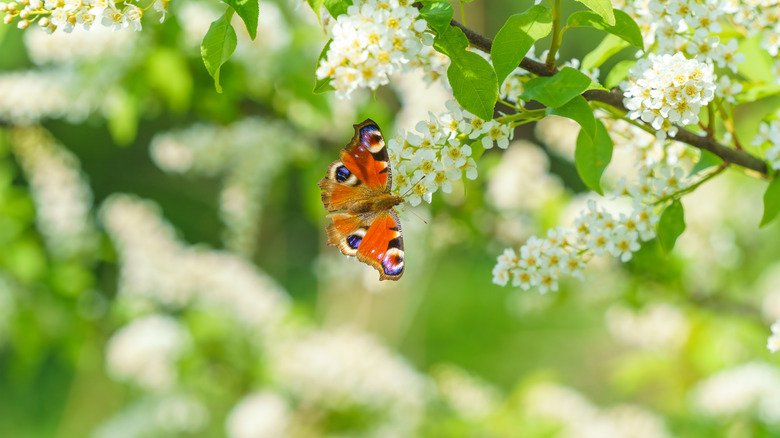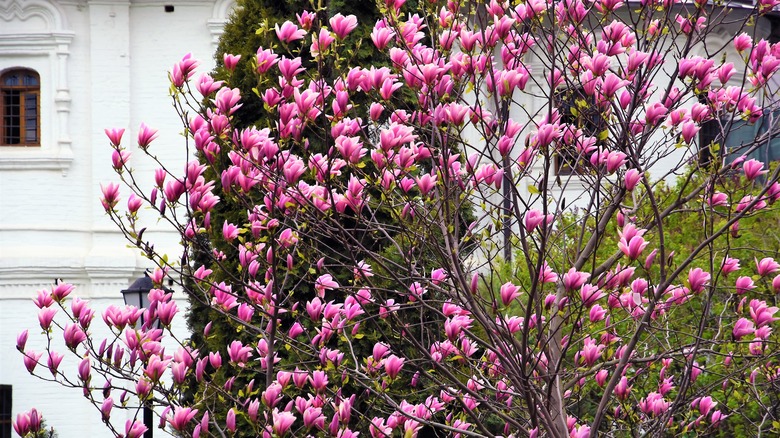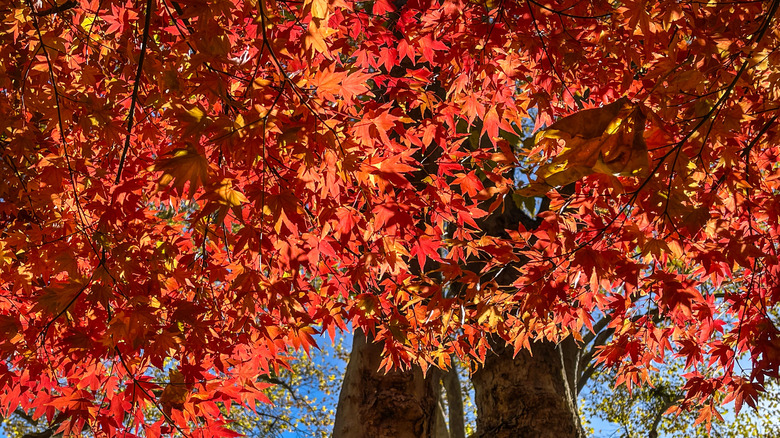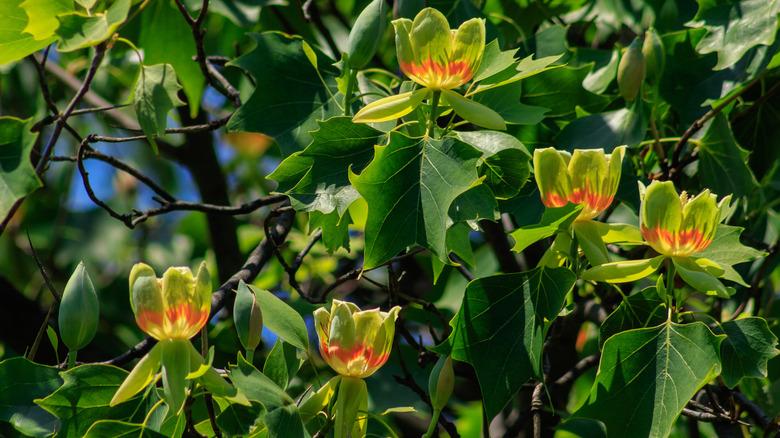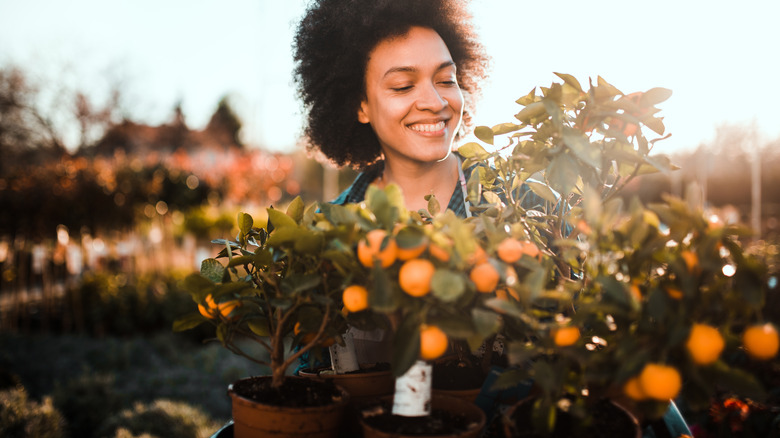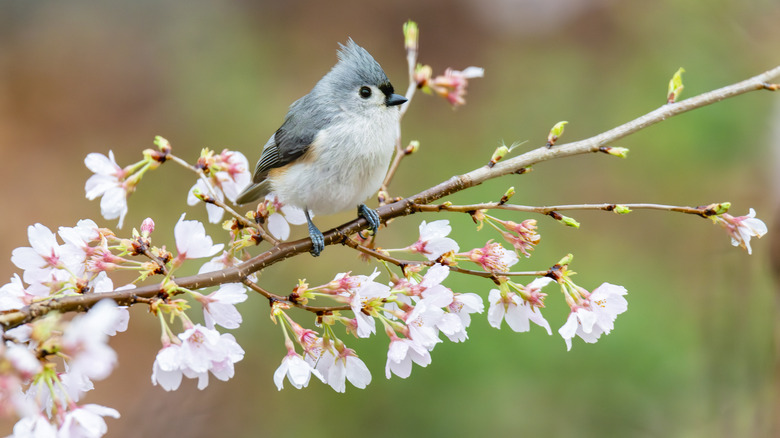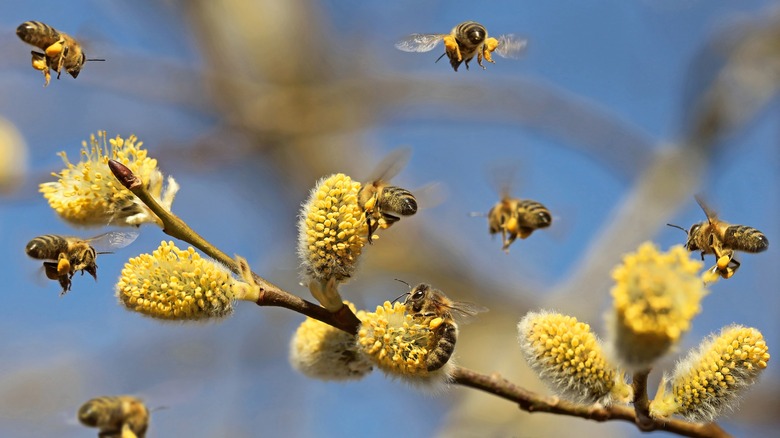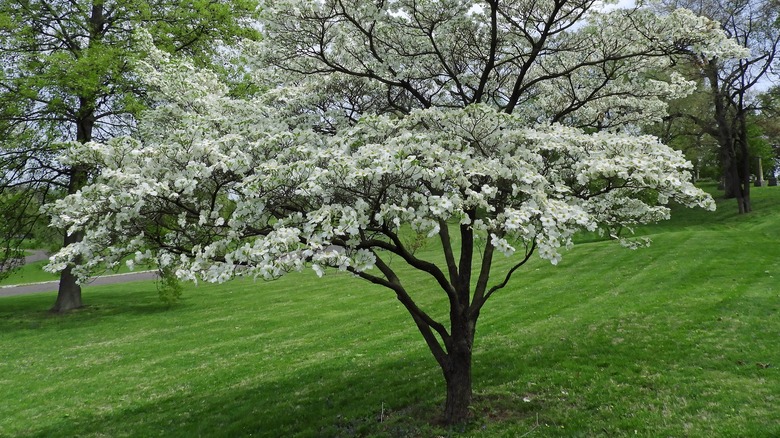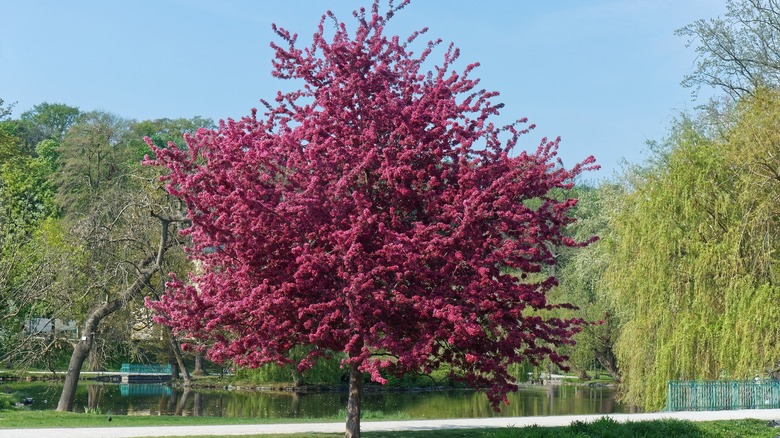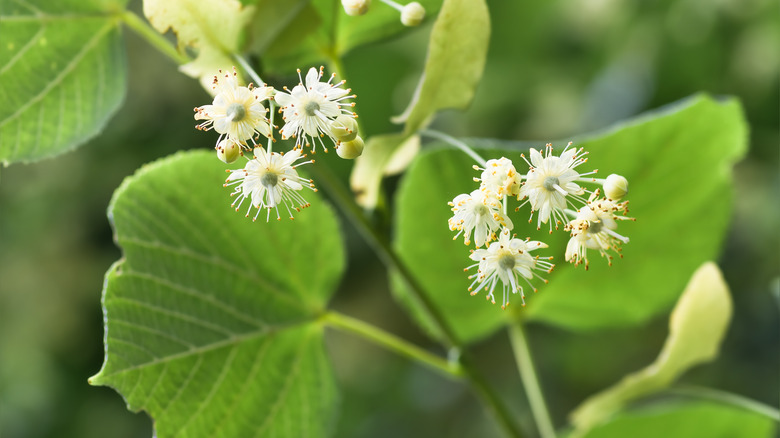9 Trees You Should Plant To Help Butterflies And Pollinators Thrive In Your Yard
When it comes to pollinating plants, you might first think of small flowering perennials. However, it's important not to discount the role that trees play in the ecosystem, as several types attract a variety of butterflies and other species. Aside from butterflies, other important pollinators include birds, bees, bats, and even beetles. As Horticulture Magazine explains, trees (especially native varieties) not only offer food to pollinators around the country, but they also provide vital shelter. Furthermore, if you plant trees that are indigenous to your region, the resulting flowers may match the life cycles of butterflies, birds, and bees in your area, ensuring that they all get enough food during key points of growth and reproduction.
Despite their advantages, it's also important to consider some of the caveats to planting trees for pollinators. For one, depending on the type of tree, it may take a few years or longer before it produces enough flowers to attract butterflies, bees, and birds. Ensuring you have enough size around your property is another consideration, as some trees grow several feet tall and need much more space than others. However, by researching and planning ahead, you may be able to plant trees that attract pollinators and improve your yard's overall aesthetic appeal.
Consider fragrant magnolia trees to attract butterflies and birds
Known for evoking Southern charm, magnolia trees are also havens for butterflies and birds. According to Save Our Monarchs, sweetbay magnolias attract a variety of butterflies in the spring due to the fragrant lemon-like scented flowers that deliver vital pollen. In particular, magnolias may provide pollen for a variety of swallowtail butterflies as well as the sweetbay silkmoth. Additionally, you may find other types of wildlife seeking shelter around magnolia trees, including squirrels and rabbits.
Magnolia trees tend to grow best in southern climates because they prefer long hours of sunshine. This is why you can find them in places like Texas, Florida, and Tennessee, but they can also be grown along the East Coast in areas as far north as Massachusetts. According to Better Homes and Gardens, magnolias range in size from smaller shrubs to imposing trees that grow more than 100 feet tall. The best way to grow and care for magnolia trees depends on the variety, but most prefer full sun, well-drained soil, and moderate humidity. Unlike other types of trees, magnolias do not like over-pruning. The best way to maintain these beautiful trees is to trim dead branches, and only after they have flowered.
Bees are fond of flowering maple trees
Maple trees are among some of the most beautiful trees you can plant. Not only do they produce pretty red flowers in the spring, but their bright red leaves are a spectacular sight in the autumn that adds drama to any yard. Maple trees are also particularly important to bees, as the tree's pollen provides a vital source of food for these insects. For example, when red maples bloom in the spring, you're most likely to see honeybees feasting on their nectar.
Maple trees make a great addition to your property while also helping out bee populations, and you have choices in size depending on how much room you have for a maple tree on your property. According to the Arbor Day Foundation, red maples are the largest, but you may consider smaller varieties, such as Japanese maple trees. However, Michigan State University advises against choosing Norway maple trees, which are considered invasive. Also, if you're looking to attract pollinators, don't plant hybrid varieties, as these do not produce flowers. In general, maples can tolerate sun and humidity, with Japanese maple trees among some of the most likely varieties to thrive in hot climates. When there's a lack of moisture in their soil, maple trees can sometimes spread their roots out looking for water, which can cause problems around your property.
Consider tulip poplars for bees and hummingbirds
If you have a relatively large space to plant trees, consider the tulip poplar. According to HGTV, this tree is the tallest indigenous hardwood tree found in the U.S. Tulip poplar trees are prized by various pollinators, including bees and other insects, as well as certain bird species like hummingbirds. Once they start flowering, tulip poplars produce beautiful yellow blossoms with orange bases that attract a variety of pollinators.
Keep in mind, however, that tulip poplars grow extremely large over time, often exceeding 100 feet, according to Backyard Ecology. While these beautiful trees attract many pollinating species, you should not plant them in small yards. You may also not see flowers for several years until they've grown quite large, at around the time the trees are about 10 to 15 years old. Another caveat to tulip poplar trees is their tendency to attract other flying insects, such as wasps. If you do plant a tulip polar, find a spot where it can get partial to full sun and far away from any septic tanks, power lines, and concrete.
A variety of fruit trees attract butterflies and bees
If you've dreamt of being able to pick fresh fruit from your backyard, you may consider certain pollinator-friendly trees as a win-win for both you and pollinator species. Bees are particularly fond of flowering apple, peach, pear, and plum trees during the spring months, per the Arbor Day Foundation. Conversely, fruit trees also rely on pollinators like bees to make fruit. Certain varieties of butterflies also flock to fruit trees for food and shelter. For example, according to the University of Minnesota, viceroys, spring azure, and red-spotted purple butterflies are attracted to apple, cherry, and plum trees.
Fruit trees are readily available in the springtime at nurseries and garden centers. The first thing to consider is what type of fruit tree you want to use to attract pollinators, but also which types might be useful for your family to pick fruit from. Also, unwanted pests, rodents, and tree diseases are some of the other important things to consider before planting a fruit tree. While there's some variation between fruit trees in terms of planting and growth, most prefer lots of sunshine. You'll also want to wait until the last frost before planting them in your yard. Adding stakes to fruit trees can help support them during the early stages of growth, especially during a windstorm.
Cherry blossoms attract bees, birds, and butterflies
Cherry blossoms are some of the most coveted trees due to their beautiful white and pink colored flowers. These are not only popular springtime trees for humans to look at — they also reportedly attract a variety of pollinators. When cherry blossom trees bloom, it's not uncommon to see birds and butterflies around them. They also attract various insects crucial to the ecosystem, such as bees and beetles. Every spring, cherry blossoms bloom around the National Mall in Washington, D.C., creating a stunning visual that attracts visitors from around the world.
Before planting cherry blossoms in your yard, know that these trees do best in more temperate climates. Also, remember that while cherry blossoms are at their peak beauty in spring, they lose their leaves in fall. These trees prefer about six hours of sunlight every day, as well as well-drained soil. According to Southern Living, there are more than 100 different types of cherry blossom trees, and they can grow up to between 15 and 30 feet tall. After planting your cherry blossom, you can expect an average growth rate of 2 to 4 feet annually, with full bloom not occurring for five to seven years. While not toxic to humans, parts of the tree may be harmful to some animals, including dogs and horses. These trees may also be susceptible to diseases, mainly from pests. However, pollinators such as birds may also feed on insects that might otherwise harm cherry blossoms.
Plant willows for bees and butterflies
If you have a lot of space in your yard, consider planting willow trees. Willows are loved by both butterflies and bees for pollen, and they also provide shelter for certain butterfly species in larval (caterpillar) stages, such as red-spotted purple, Compton tortoiseshell, and northern pearly eye butterflies, according to Save Our Monarchs.
Willow trees tend to grow well in areas with moist soil, such as along the Pacific or Atlantic coasts, and they also pollinate earlier compared with other trees on this list. There are also different varieties and sizes to consider, with weeping willows needing more space and cool air and American willows taking up less room and thriving in cooler climates. Depending on whether you plant a small or large willow, the maximum height can range between 3 and 50 feet. As long as their soil is moist and they get plenty of sunlight, willow trees are also considered relatively low-maintenance.
Dogwood trees are smaller options for birds and bees
While you may like the idea of planting large trees in your yard, not everyone has the space for red maples, tulip poplars, or other tall trees. The good news is that you can still plant smaller trees and reap the benefits of attracting pollinators to your yard without having to plant ones that will eventually become massive. Take dogwood trees, for example. While some can grow tall, most of these trees are small varieties that attract a variety of birds and bees, and they are also indigenous to eastern regions of North America. The average dogwood tops out at 6 to 30 feet, producing white to yellow flowers that appeal to both homeowners and pollinators such as bees, and birds like robins and sparrows.
When planting a dogwood tree in your yard, you'll want to ensure that you pick the right variety according to the size it may reach at maturity. Flowering and Pacific dogwood varieties are among the tallest, while the red twig dogwood remains relatively small. Dogwoods prefer partial morning sunlight, and they may not produce flowers until their second year.
Crabapple trees are also smaller options for birds and bees
If you have a smaller plot of land and don't want the large roots of tulip poplars or other massive trees, you may consider crabapple trees. Like dogwood trees, these don't take up as much space to grow, but they still attract a variety of pollinators. Also, like dogwood, crabapple trees are native to North America. Crabapple trees are among some of the most dependable pollinators of all apple varieties, and you're sure to attract birds and bees as the trees produce their white or pink flowers in the spring. Outside of spring, crabapples also provide beautiful fall foliage in peak autumn months.
While crabapple trees don't need too much space to grow, remember that they are often wider than taller. The average width of a crabapple tree ranges between 15 and 25 feet, while its height can range between 8 to 20 feet. You can plant a crabapple tree in the spring or fall months in areas with full sun. These trees can tolerate heat but don't do well in areas of high humidity and mild winters. Depending on the region, there are also several types of crabapple trees you can consider planting in your yard.
Consider American linden trees for bees and butterflies
Also known as basswood trees, American lindens are other types of trees that bees and butterflies favor for their yellow springtime blossoms. In fact, Horticulture Magazine says that the fragrant flowers on American linden trees can attract pollinators from several miles away. These trees also produce berries that birds love.
American linden trees may be a good option if you have a large yard and live in an area with harsh winters. While these trees are sometimes susceptible to wind damage, they are known for their winter hardiness. However, American linden trees are also sensitive to drought and over-saturation of the soil, which can pose challenges if you live in an area with little or too much rain. When planting one in your own yard, know that the tree needs a lot of room to grow and should not be planted near your home or other nearby structures. There are also several varieties of American linden trees to choose from, some of which may grow up to 50 feet tall.
